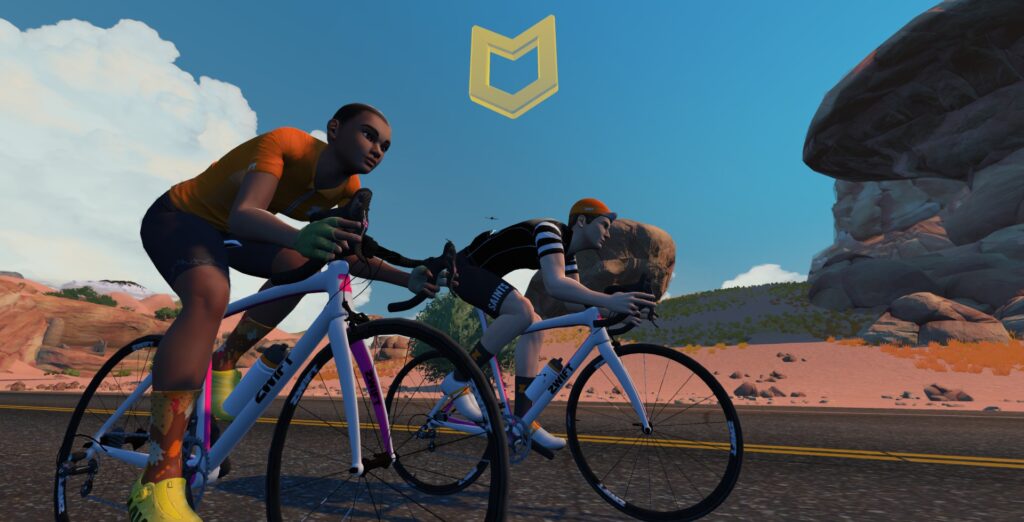UPDATE: Zwift greatly improved their banding algorithm after this post was published. To see current “keep together” test results, read the updated post.
How does Zwift’s “Keep Everyone Together” logic work? I’m not entirely sure, but after publishing speed test results for rubberbanded Club events many Zwifters said “Keep Everyone Together” mode behaves differently in Meetups than Club events!
That seemed goofy to me… why would Zwift have two different Keep Together algorithms? I knew I had to run some tests to see if the rumors were true.
In addition to seeing if rubberbanding behaves differently in Meetups than in Club events, these tests were also done to answer the question do rubberbanded speeds in Meetups make sense? Or are they too slow, too fast, or some strange mix of both?
The riders in these tests were 75kg in weight, 183cm tall, and rode Zwift Carbon bikes with 32mm carbon wheels. I timed the riders on the Fuego Flats Reverse segment since it’s flat and long enough to get a stable speed reading.
Test 1: A Pair of Bots

This first round of tests used just two riders in a Meetup event with “Keep Everyone Together” mode enabled. Here are each rider’s power outputs, segment times, and average speeds.
| Rider 1 | Rider 2 | Time | Speed (kph) |
| 300W | 300W | 10:19 | 41.06 |
| 300W | 225W | 10:55 | 38.8 |
| 300W | 150W | 10:56 | 38.74 |
| 300W | 75W | 10:56 | 38.74 |
| 300W | 10W | 10:56 | 38.74 |
| 225W | 225W | 11:42 | 36.2 |
| 225W | 150W | 12:09 | 34.86 |
| 225W | 75W | 12:09 | 34.86 |
| 150W | 150W | 12:37 | 33.57 |
| 150W | 75W | 14:10 | 29.9 |
Observations
The first thing that stands out here is how much faster the riders moved compared to a banded Club event. Here’s a comparison table:
| Solo Rider | Banded Meetup (2 Riders) | Banded Club Event (2 Riders) | Club Event (4 Riders) | |
| 300W | 40.23 kph | 41.06 kph | 32.58 kph | 40.19kph |
| 225W | 35.95 kph | 36.2 kph | 28.72 kph | |
| 150W | 30.81 kph | 33.57 kph | 26.12 kph |
Looking at these comparisons, it’s clear that the riders in the banded Club events were moving much too slowly, while the banded Meetup is pretty close to accurate. (Two riders holding 300W in a banded Meetup are just slightly faster than a standard event with 4 riders holding 300W.)
So something is clearly different with Zwift’s “Keep Everyone Together” algorithm for Meetups vs Club Events. Interestingly, though, both types of events share the same odd behavior when it comes to having a “strong” rider pulling a “weaker” rider. The results above, just like the Club event results, show that times don’t change as the weaker rider’s power decreases.
That is, when Rider 1 is holding 300W and Rider 2 is holding 225W, they’re traveling at the same speed as when Rider 1 holds 300W and Rider 2 holds 75W. That’s strange. Shouldn’t groups travel significantly faster if the group’s average power increases significantly?
Test 2: Solo Rider

Next, I wanted to test if a solo rider in a rubberbanded Meetup still traveled as slowly as the paired riders above. So I created a Meetup with “Keep Everyone Together” enabled, but only had one rider join. Here are the results:
| Rider 1 | Time | Speed (kph) |
| 1000W | 60 | |
| 300W | 10:56 | 38.74 |
| 225W | 12:09 | 34.86 |
| 150W | 14:09 | 29.94 |
Observations
First, notice that the times for the solo riders matched the times when we paired up two riders, but one was doing less power than the other (see Test 1 above). That’s certainly not a coincidence. And it actually matches what would happen outside! That is, you would travel at the same speed riding alone at 300W as you would if you held 300W but had a weaker rider sitting on your wheel.
Secondly, notice that the solo rider times in this test are slower than solo rider times when in free ride mode. They’re not nearly as far off as my solo rider tests in banded Club events, but they’re still off.
The 1000W test is also interesting since it’s sort of a “max speed” test that shows if banded Meetups have high speeds impacted. In rubberbanded Meetup mode the rider reached 60kph, while in free ride mode the same rider holding 1000W reaches around 62kph. Again, much closer than the banded Club ride (where the 1000W rider could only hit 47kph). But still not quite the same speed as a free ride.
Concluding Thoughts
These test results clearly show that “Keep Everyone Together” mode in Meetups behaves very differently from “Keep Everyone Together” mode in Clubs. Specifically, banded Meetups are markedly faster than banded Club events.
And that’s weird, right? I can’t think of any reason why Zwift would want to run two different versions of “Keep Everyone Together.”
Do banded Meetup speeds make sense? Or do they feel too fast, or too slow? My hunch is they may feel pretty accurate for medium and high-strength riders, since pack speeds in these limited tests are mostly aligned with the power being done by the stronger rider. For that reason, speeds may feel a bit fast for low-powered riders, since they’re effectively being pulled along at the strong rider’s speed, even if they’re putting out next to zero power.
Nobody will be breaking land speed records with the current algorithm like they did with the buggy one in years past, but for sure a rider who can only hold 100W is going to set a lot of Strava PRs if they jump into a banded Meetup with riders who can hold 300W!
Because of this, perhaps Zwift should consider tagging banded activities as “gamified” when posting to Strava, so the activities don’t show up on leaderboards or count for PRs. What do you think?
Coming Up Next
I’ll be testing speeds in a group workout to see if the algorithm that keeps riders together in these events matches up with either the Meetup or Clubs “Keep Everyone Together” algorithm. For science!
Also, we’re working on banded Meetup and Club event tests on Alpe du Zwift, to see how rubberbanding behaves on long climbs. Stay tuned!
Questions or Comments?
Share below!